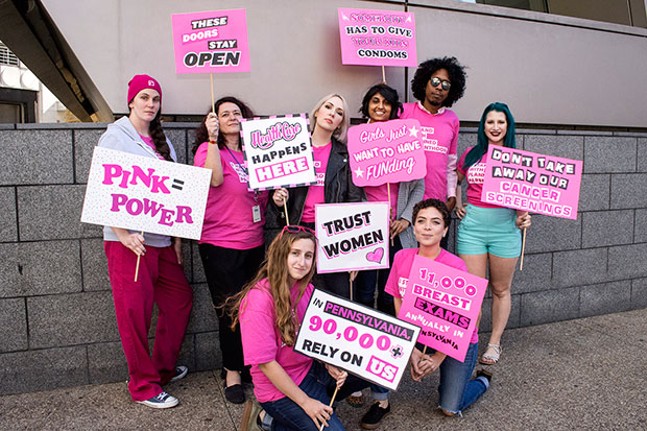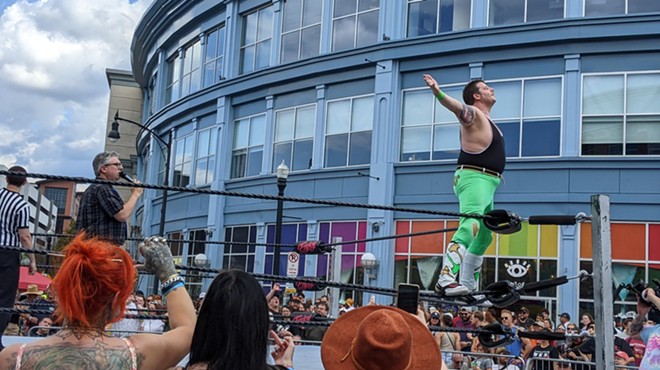Gina DeAngelo was a college student in her early twenties when she noticed a lump on her breast. She instantly had two thoughts. The first was about her grandmother who died of cancer just a few years prior; the second was her lack of health insurance.
“I was completely terrified,” DeAngelo says. Without insurance, she didn’t know where to turn to get a diagnosis, let alone what she might do if it turned out that she did have breast cancer. “I sat on it for a couple of months, alternating between feeling really stressed out and just pushing it out of my mind.”
When she finally faced it, she came up with one option: Planned Parenthood of Western Pennsylvania. On a Saturday, during walk-in hours, DeAngelo headed to the Planned Parenthood office Downtown, only to encounter a crowd of loud, angry protesters.
“They screamed at me on my way in, I was so shaken up,” she says. “It made me so mad, because it took me a really long time to get the courage up, figure out where I could go and actually go there.” DeAngelo noticed the strange juxtaposition that a lot of Planned Parenthood clients experience. Inside, “there was a group of extremely helpful people that were the only help that I had; outside, there was this big group trying to make sure that I wasn’t able to have access to that care.”
Luckily, DeAngelo did get free access to health care, thanks to Planned Parenthood. After performing a clinical exam, Planned Parenthood decided that she did need further testing and provided her with a prescription for a mammogram and a voucher that would cover the cost. After the mammogram, a needle biopsy was taken, and the eventual results were negative. DeAngelo gives Planned Parenthood the credit for her peace of mind.
Despite the countless times that Planned Parenthood has helped its clients, it has — especially in recent years — faced constant threats of having its federal funding pulled by Congress. Most of that fight is fueled by rhetoric that claims federal dollars are paying for abortions. However, that is simply not true. First, there’s no federal budget line item that “funds” Planned Parenthood. The organization receives its money largely through Medicaid reimbursements after a patient receives health-care services (about $554 million last year). Secondly, there is already a federal law known as the Hyde Amendment (passed in 1976). That law specifically prohibits federal dollars from being spent on abortion services, except in the case of rape or incest or if the mother’s life is in danger. Many women, however, see Planned Parenthood as a lifeline to medical treatment they, perhaps, wouldn’t get otherwise. If Planned Parenthood funding is shut down, the group estimates, about 1.5 million patients would be left without access to women’s health services.
Planned Parenthood’s job is to provide health care, and almost all of its clients are women. According to its 2015-2016 annual report, Planned Parenthood of Western Pennsylvania had 17,325 patient visits that year, 16,274 of them by women. Thirty-six percent of its patients accessed their services through Medicaid, and 18 percent paid according to a sliding-fee scale, which charges patients relative to their income.
“For many of our patients, Planned Parenthood is the gateway into the health-care system, and we serve some of the most vulnerable populations,” says Planned Parenthood of Western Pennsylvania Certified Nurse-Midwife Rachel Gallagher.
There are many barriers that keep people from accessing the health-care system in the United States. Cost and lack of insurance are the biggest.
“People who are uninsured have more difficulty accessing the health-care system, and sometimes even those who are insured, depending on their type of coverage, can [have] a problem,” says Kim Evert, CEO and president of Planned Parenthood of Western Pennsylvania. “We see a lot of plans that have very high deductibles, co-pays, co-insurance, and so it can still be very costly for someone to have a visit at a health-care provider.”
While women’s reproductive health is a major component of Planned Parenthood’s services, it also plays a large part in early detection of breast cancer in low-income and underserved populations. Last year, Planned Parenthood of Western Pennsylvania provided 2,957 breast exams. When it comes to breast cancer, early detection — and access to health-care services — is critical.
“We look at the five-year mortality rate for breast cancer, and we see that the survival rate is actually rather high as long as people seek care early. The earlier breast cancer is detected and treatment is initiated, their survival rate is higher,” says Gallagher.
The Pennsylvania Department of Health estimates that 78,284 new cases of all types of cancer will be diagnosed in Pennsylvania in 2017, 7,934 of those in Allegheny County. Breast cancer is the most commonly diagnosed cancer in Pennsylvania.
The Department of Health projects that by the end of this year, 11,315 women across the state will be diagnosed with breast cancer and 1,825 of them will die from the disease. Between 2004 and 2014, there was a 24.8 percent decrease in the mortality rate for women in Pennsylvania with breast cancer, largely because of increased emphasis on early detection.
In order to improve early detection of health problems like breast cancer, Planned Parenthood has implemented several services, including the sliding-fee scale, walk-in hours, and enrolling patients in programs that provide them with vouchers for screenings such as mammograms. One of those programs is called HealthyWoman.
HealthyWoman, which is funded by the Pennsylvania Department of Health and the federal Centers for Disease Control and Prevention, provides free breast- and cervical-cancer screenings to women who meet certain requirements.
“The whole point of having this program … was to address this whole barrier of early detection in women who were completely uninsured,” says Bonnie DeLozier, the cancer-screening regional program manager of Adagio Health, a nonprofit specializing in gynecological health for women. “If you have to choose between putting food on the table and getting your annual gynecological exam, you’re going to put food on the table.”
Women in Pennsylvania over age 21 can have the costs of clinical breast exams, mammograms, pelvic exams and any necessary follow-up diagnostic tests covered under the HealthyWoman program, if they are uninsured or underinsured and have an income of 250 percent or less of the federal poverty level. Many women who are not eligible for Medicaid are eligible for HealthyWoman.
“There are 30 sites in Allegheny County alone, and over 55 sites within the 23 counties of Western Pennsylvania, where people can enroll in the program,” DeLozier says. “The Planned Parenthood offices in Pittsburgh, Bridgeville, Moon and Greensburg are all HealthyWoman intake sites.”
Even though Planned Parenthood provides access to many different services, the nonprofit organization continues to receive significant attention for providing abortion services. However, according to the organization’s annual report, abortion services account for only 3 percent of its work. That aspect of Planned Parenthood’s care has made it a target for defunding by conservative members of Congress. A loss of Planned Parenthood would force a lot of women to find another option for their health care. And unfortunately, other options just aren’t available.
“Having [women’s health] become a political issue, instead of a health issue, has a huge human cost: It’s women, it’s children, it’s families,” says DeAngelo, who after her experience as a patient at Planned Parenthood was inspired to pursue a career in public health and become a volunteer for the organization.
“Right now, approximately 30 to 35 percent of the patients we see receive [Medicaid] for their health-care coverage,” Evert explains, citing her concerns should federal funding be cut.
“The big impact,” Evert says, “is on people with lower incomes, who need access to affordable services, [and] who will no longer have that access and whose health and care will suffer because of it.”



















